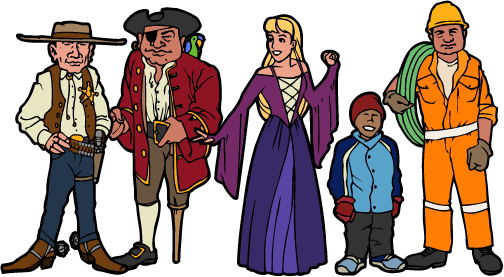Lesson 3.1C: Character and Characterization
One of the most enjoyable parts of reading a good novel is becoming attached to the characters. When we start to care about the characters' successes and failures, and start to understand their strengths and weaknesses, we have entered into the world of the story. More than that, we have brought the characters and their stories into our world. Have you ever read a book that you didn't want to end because you liked the characters so much?
In this lesson, you will read more of your novel, and then we will look at how an author uses characterization to develop the characters in a novel. After that, we will look more closely at some of the characters in your novel, and develop a character sketch of the main character.

Getting to Know the Main Character
 It is time to read further in your novel. Please read the next segment of your novel as listed below. Remember that chapter notes are very useful. It is time to read further in your novel. Please read the next segment of your novel as listed below. Remember that chapter notes are very useful.
Read the following sections of your novel: Painting the Black, Chapters 4
|
Kinds of Characters
The author has developed several complex characters in your novel. A complex character is also called a round character, a character who has many sides and who is complicated like a human being.
A flat character shows only one side, and is usually a stereotype or a stock character. Stock means the character is a "typical" example of a group of people; some examples are a friendly fireman who saves kittens from trees, and a crabby librarian who wears heavy glasses and scowls. These figures represent respectively all firemen and all librarians, though they don't represent any particular individual.
Next, we will look at how the author has developed round characters in your novel. This lesson will prepare you to develop a character sketch of the main character, who is always a round or complex character.
Discussion Prompt |
At home discuss popular TV shows, movies, video games, and stories, and list the round and flat characters from each. |
Guidelines for contribution:
Volunteer at least one example of a round and a flat character in a TV show, story, or other example. Click here to add your journal entry now. |
Methods of Characterization
We learn about the characters in a novel in many ways. The process of creating believable characters, and of sharing information through characters, is called characterization.
The methods authors use to create their characters are:
- telling us directly what kind of person the character is
- describing the character's physical appearance, habits, clothing, and environment
- showing what the character says
- showing what the character does
- showing what other characters say about him or her
- telling what the character thinks
 View Building a Character to learn more about developing a character. View Building a Character to learn more about developing a character.

Journal Entry 3.1C: Characterization
Answer the following question in the journal section of the assignment template.
How would an author portray you in a story? Using four of the six methods of characterization listed in the following example, write a few lines of description that show your character through each of the methods you have chosen. Or, if you prefer, invent a character, as in the following example.
Notice that in the four short descriptions that follow we learn a lot about "Mrs. Webber," and some character descriptions contradict each other: she seems to be happy to volunteer, but really she wishes that more parents would get involved.
- Example: She stood at the counter and quickly finished her breakfast, tidying the counter as she ate.
Method: showing what the character does
- Example: "Yes, I would be happy to volunteer for the fall dance. Should I bake some cupcakes too?"
Method: showing what the character says
- Example: "Mrs. Webber is an amazing woman; I don't know how she manages to do so much and keep such a tidy house," Mrs. Arnold commented.
Method: showing what other characters say about her.
- Example: If only a few more parents would get involved in their kid's activities, then I'd have a few minutes to sit down, thought Mrs. Webber.
Method: telling what the character thinks
Now create your own four examples in your Journal. Include the method of characterization used in each example, as shown above.
|
 Grammar Checkup Grammar Checkup
Go to Writing on the Run! and complete the tutorial and exercises on "Run-on Sentences."
Summary
Completing this lesson has helped you to:
- describe the main character of the novel and provide supporting evidence
- compare or contrast the main character to another character
- form an opinion about the integrity of the main character
Section 1 Summary
You have now completed Section 2.1: Who Is in Charge of Your World. You have explored a number of concepts in this section relating to first impressions, theme statements, setting, and character. You may need to refer back to specific lessons in order to successfully complete the section assignments.
Review the following list to ensure you have completed all assignments for this section:
- Section Assignment 3.1A: Character Analysis
- Section Assignment 3.1B: Character Questions
- Section Assignment 3.1C: Looking Between the Lines
- Section Assignment 3.1D: Grammar Quick Quiz
- Section Assignment 3.1E: Journal Entries
|

